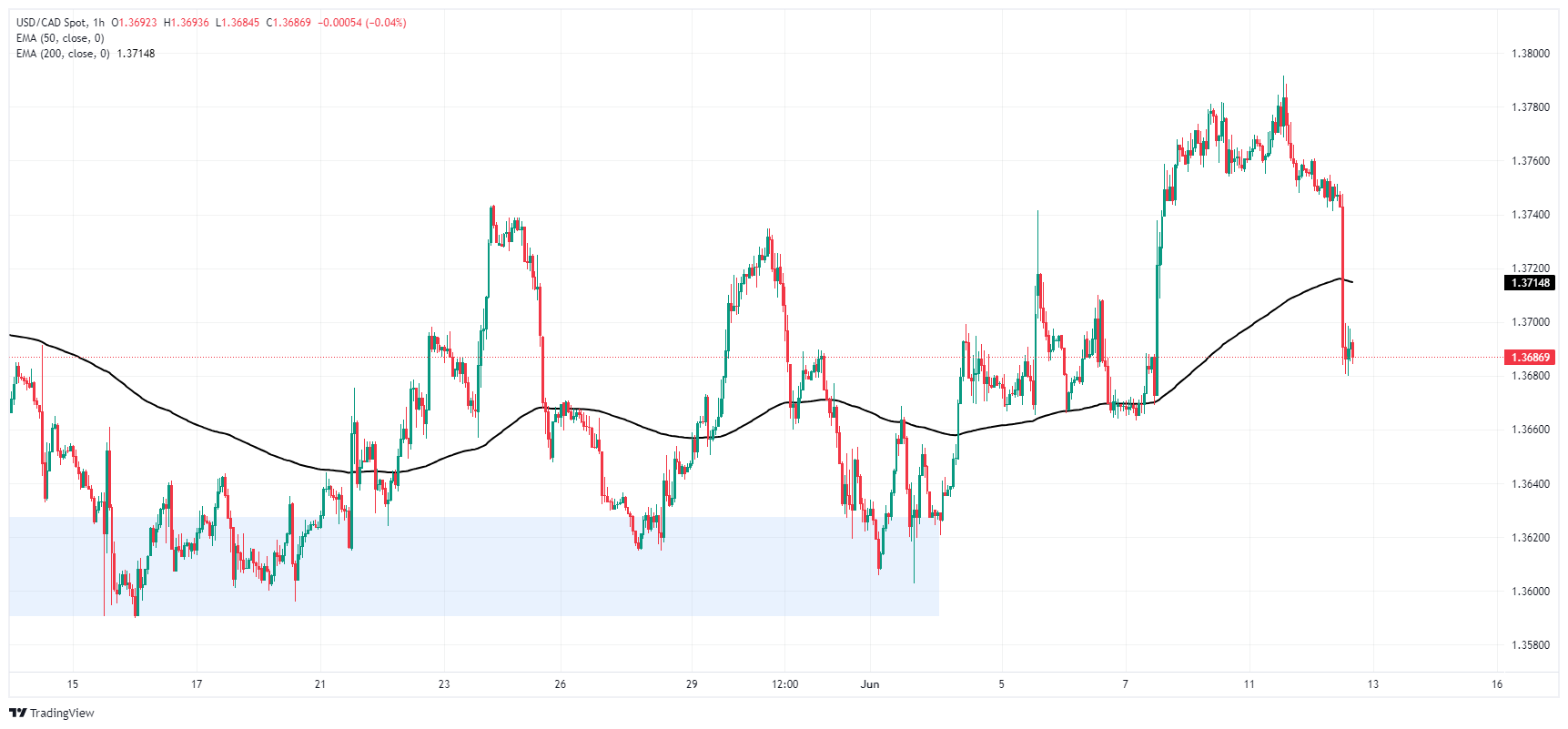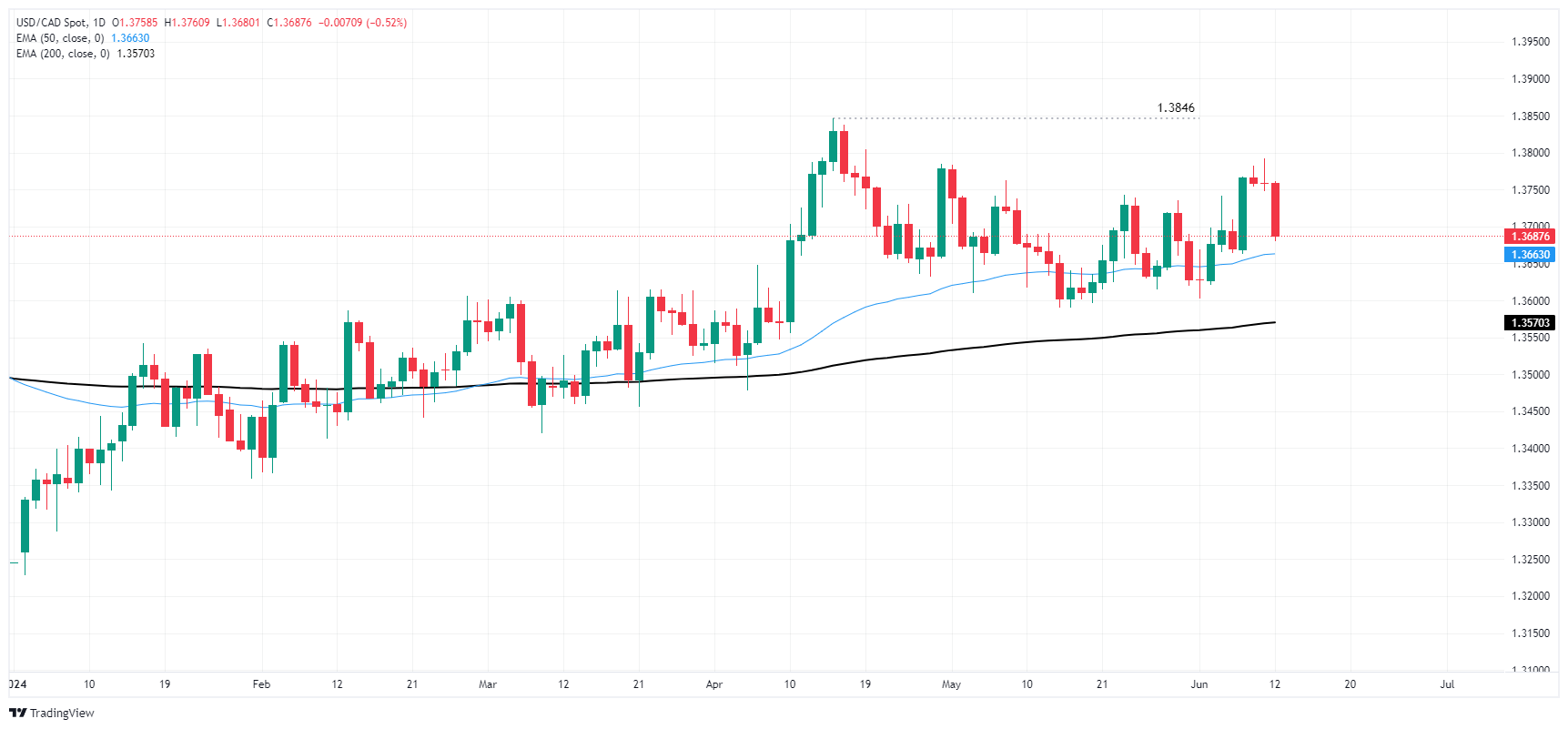- The Canadian Dollar weakens broadly on Wednesday, but the Dollar is not far behind and fell further.
- Canada provides little of interest, BoC Governor Tiff Macklem is expected to make statements later.
- Slowing US CPI inflation bolsters market sentiment ahead of Fed ‘dot plot’.
The Canadian Dollar (CAD) fell sharply on Wednesday, bearish against most of its competitors. However, a lower-than-expected US Consumer Price Index (CPI) inflation figure has bolstered broader market sentiment, pushing the US dollar lower even faster than the CAD.
Canada doesn’t offer much of interest on the economic calendar for the rest of the week. An appearance by Bank of Canada (BoC) Governor Tiff Macklem, scheduled for later Wednesday, will likely be overshadowed by market reactions to the Federal Reserve’s (Fed) latest “dot plot” update on projections. of interest rates.
Daily Market Summary: Canadian Dollar Weakens, But Dollar Declines Strongly Following US CPI
- US CPI inflation slowed to 0.0% mom from 0.3% previously, falling below the forecast of 0.1% in May.
- Core CPI inflation fell to 3.4% month-on-month in May, below the forecast of 3.5% and retreating further from 3.6% in the previous period.
- Signs of slowing inflation hit the dollar and raised hopes of a September rate cut by the Fed. The CME’s FedWatch tool shows rates markets are again pricing in more than a 70% chance of at least a quarter-point cut by the Fed on September 18.
- The Fed’s updated interest rate projections will be released at 18:00 GMT, along with another expected rate hold, and will be followed by a press conference led by Fed Chair Jerome Powell at 18: 30 GMT.
- BoC Governor Tiff Macklem will participate in a panel discussion titled “Overcoming Economic Volatility” during one of the most volatile days of the season at the Montreal Conference starting at 19:30 GMT.
Price of the Canadian Dollar Today
The table below shows the percentage change of the Canadian Dollar (CAD) against the major currencies listed today. The Canadian Dollar was the strongest against the US Dollar.
| USD | EUR | GBP | JPY | CAD | AUD | NZD | CHF | |
|---|---|---|---|---|---|---|---|---|
| USD | -0.95% | -0.79% | -0.84% | -0.48% | -1.37% | -1.15% | -0.72% | |
| EUR | 0.95% | 0.17% | 0.08% | 0.44% | -0.44% | -0.19% | 0.23% | |
| GBP | 0.79% | -0.17% | -0.06% | 0.30% | -0.57% | -0.33% | 0.07% | |
| JPY | 0.84% | -0.08% | 0.06% | 0.34% | -0.53% | -0.31% | 0.12% | |
| CAD | 0.48% | -0.44% | -0.30% | -0.34% | -0.89% | -0.63% | -0.25% | |
| AUD | 1.37% | 0.44% | 0.57% | 0.53% | 0.89% | 0.25% | 0.66% | |
| NZD | 1.15% | 0.19% | 0.33% | 0.31% | 0.63% | -0.25% | 0.41% | |
| CHF | 0.72% | -0.23% | -0.07% | -0.12% | 0.25% | -0.66% | -0.41% |
The heat map shows the percentage changes of the major currencies against each other. The base currency is chosen from the left column, while the quote currency is chosen from the top row. For example, if you choose the Canadian Dollar from the left column and move along the horizontal line to the US Dollar, the percentage change shown in the box will represent CAD (base)/USD (quote).
Technical analysis: Canadian dollar declines but dollar falls faster
The Canadian Dollar (CAD) is broadly weaker on Wednesday, retreating against most of its major currency pairs. The CAD is almost one percentage point down against the Australian Dollar (AUD) and three-quarters of a percentage point against the New Zealand Dollar (NZD). Despite weak bids for the CAD, the Dollar is falling faster, driving the CAD to a half percentage point gain against the US Dollar.
USD/CAD is on track for one of its worst days in 2024, retreating half a percentage point and falling below 1.3750 as the pair routinely fails to advance beyond the 50-day EMA at 1.3663. A drop below key technical levels will see the pair extend declines towards a near-term demand zone below 1.3630, where a price bottom in the 1.3600 zone awaits.
USD/CAD Hourly Chart
USD/CAD Daily Chart
The Canadian dollar
The key factors that determine the price of the Canadian dollar (CAD) are the level of interest rates set by the Bank of Canada (BoC), the price of oil, Canada’s main export product, the health of its economy, inflation and the trade balance, which is the difference between the value of Canadian exports and its imports. Other factors are market confidence, that is, whether investors bet on riskier assets (risk-on) or look for safe assets (risk-off), with the risk-on being positive for the CAD. As its largest trading partner, the health of the US economy is also a key factor influencing the Canadian dollar.
The Bank of Canada (BoC) exerts significant influence over the Canadian Dollar by setting the level of interest rates that banks can lend to each other. This influences the level of interest rates for everyone. The BoC’s main objective is to keep inflation between 1% and 3% by adjusting interest rates up or down. Relatively high interest rates are usually positive for the CAD. The Bank of Canada can also use quantitative easing and tightening to influence credit conditions, with the former being negative for the CAD and the latter being positive for the CAD.
The price of oil is a key factor influencing the value of the Canadian Dollar. Oil is Canada’s largest export, so the price of oil tends to have an immediate impact on the value of the CAD. Generally, if the price of oil rises, the CAD also rises, as aggregate demand for the currency increases. The opposite occurs if the price of oil falls. Higher oil prices also tend to lead to a higher probability of a positive trade balance, which also supports the CAD.
Although inflation has traditionally always been considered a negative factor for a currency, as it reduces the value of money, the opposite has actually happened in modern times, with the relaxation of cross-border capital controls. Higher inflation often leads central banks to raise interest rates, attracting more capital inflows from global investors looking for a lucrative place to store their money. This increases the demand for the local currency, which in the case of Canada is the Canadian Dollar.
The published macroeconomic data measures the health of the economy and may have an impact on the Canadian dollar. Indicators such as GDP, manufacturing and services PMIs, employment and consumer confidence surveys can influence the direction of the CAD. A strong economy is good for the Canadian dollar. Not only does it attract more foreign investment, but it may encourage the Bank of Canada to raise interest rates, resulting in a stronger currency. However, if economic data is weak, the CAD is likely to fall.
Source: Fx Street
I am Joshua Winder, a senior-level journalist and editor at World Stock Market. I specialize in covering news related to the stock market and economic trends. With more than 8 years of experience in this field, I have become an expert in financial reporting.






.jpg)
